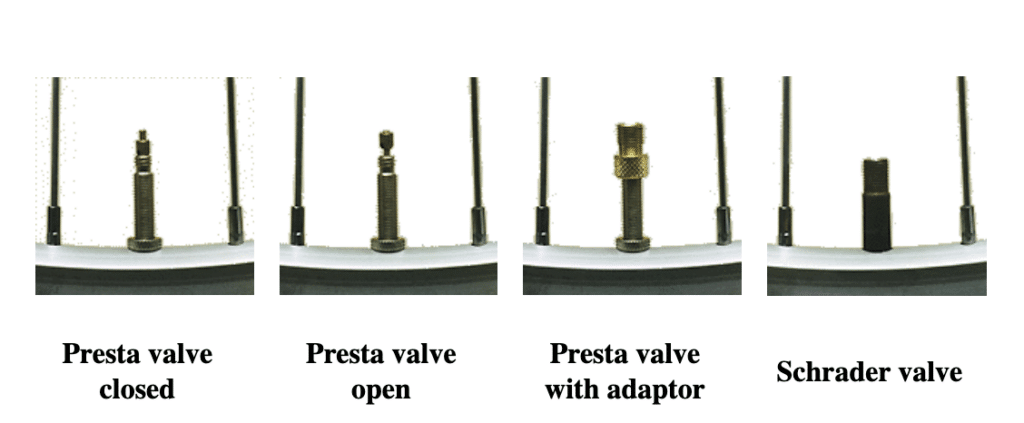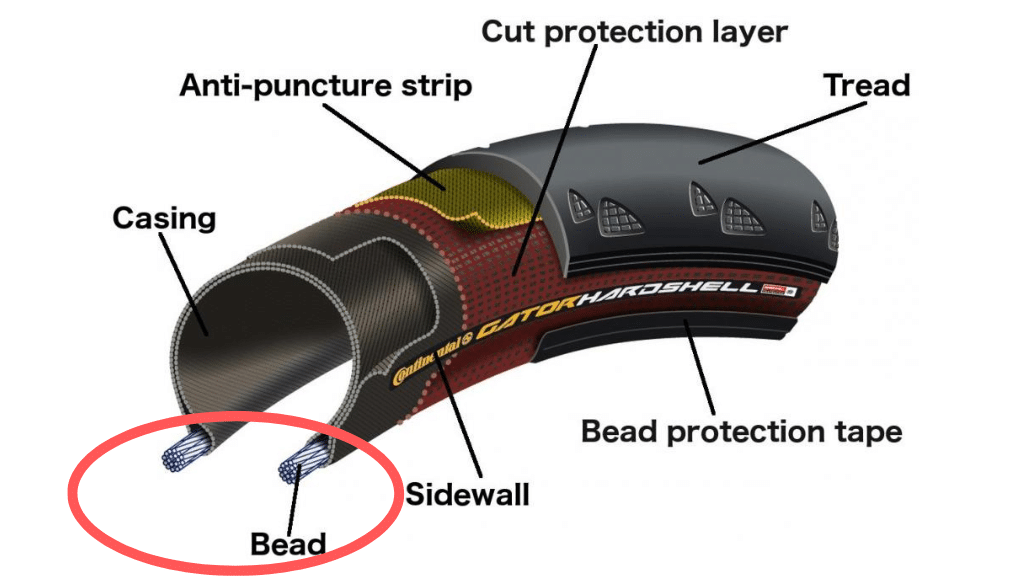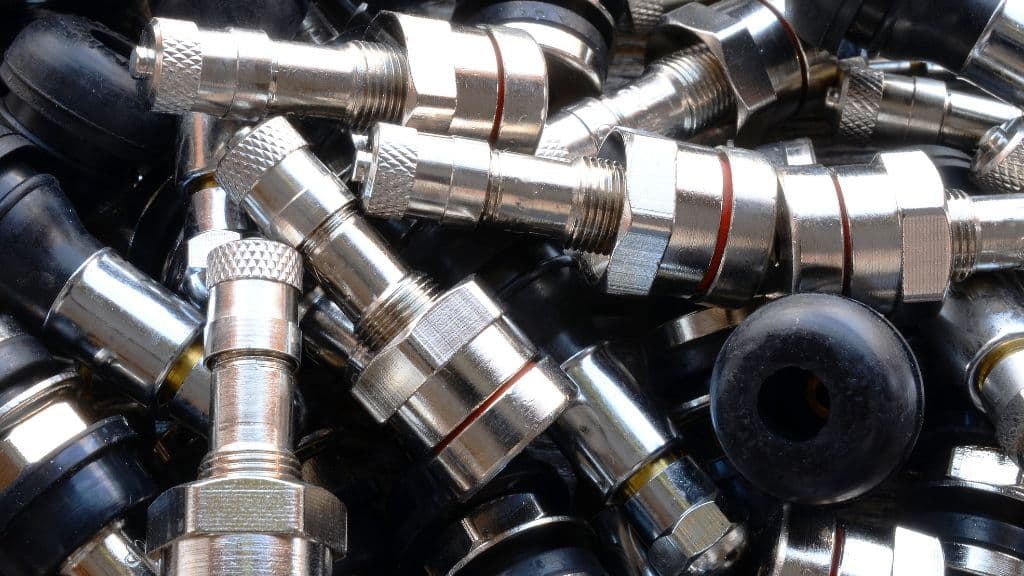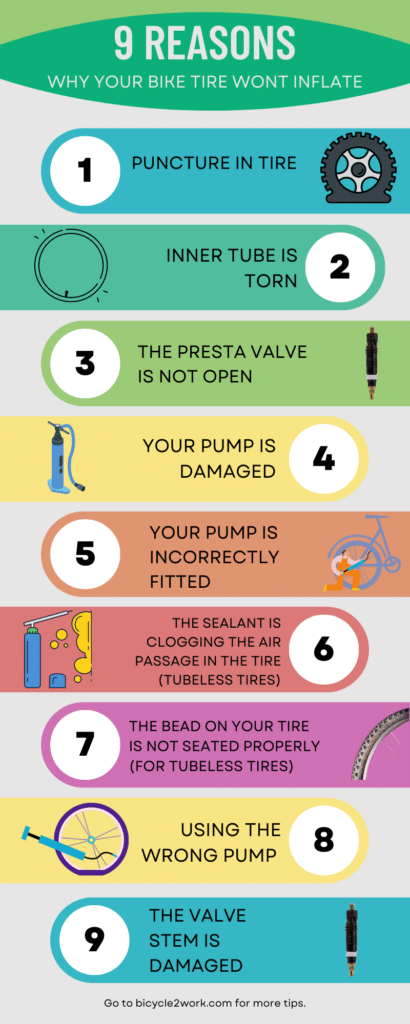This post may contain affiliate links. If you click an affiliate link and make a purchase, I may earn a commission. Also, as an Amazon Associate, I earn from qualifying purchases.--
Do your tires keep losing air? Is air not going into your tire valve? One of the most annoying things any cyclist can go through is not being able to pump or keep their tires inflated when they need them most. However, this happens to cyclists at all levels, and if you’re here because you’ve tried all you can and yours still isn’t inflating then you’re at the right place!
So then, why won’t your tires inflate? It could be due to a puncture, the pump not being suitable or set up properly, the Presta valve not being open (if you have one), or damage to the valve stem. The tire bead could also not be seated properly on the rim, and there could be issues caused by a sealant (for tubeless tires).
In this article, we will cover all the reasons why they occur. We’ll also dive into how to fix them, and provide tips to ensure your tires stay (and can be) inflated. Let’s get started!

1. Puncture In Tire
You may have been able to fill your tires with air and later found them getting softer. This is possibly due to a puncture in your tire. A puncture in your tire can be caused by:
- Your tire being worn out – As you use the tire over time, it will wear down until there is little rubber left; making your tire prone to punctures. Signs of cracks, cuts, and general wear & tear can also be signs that your tire is worn out.
Solution: Consider replacing your bike tire. You can find your tire’s dimensions on its sidewall (usually its width and diameter). Use this to get a fitting replacement for your bike.
- Riding over debris and potholes on the road – these can have sharp edges and can puncture your tire if you ride over them hard.
Solution: If your inner tube is torn as a result of this, then check out the next section on how to fix it. Consider avoiding debris on the road if safe to do so. If you can’t, then go over it carefully.
Solution: Consider replacing your bike tire if it’s punctured. Next time you ride, use the pressure recommended by the manufacturer of the tire or check out this article where we recommend road bike tire pressures based on a variety of factors.
2. Inner Tube Is Torn
- A torn inner tube is likely caused by riding over debris or a pinch flat. A pinch flat happens when your tire’s inner tube is punctured as a result of the tire going over a sharp edge with enough force. It is normally a result of underinflated tires.
Solution: If your tire’s inner tube is punctured, you should locate the puncture and apply a sticky patch over it to seal it. To do this remove the wheel, tire, and then the inner tube. Locate the puncture by slightly inflating the tube.
Put the tube in a water bowl and push out the air from the tube until you see where the bubbles appear. Mark that spot and apply the patch over it when the tube is dry.
3. The Presta Valve Is Not Open
Presta valves are more slender but less straightforward to use than Schrader valves (source). They have a lock nut instead of a spring to close it. You can see how the presta valve looks when it’s open in the image below.
Solution: Here is how you open the Presta valve: Take off the protective cap and open the nut by turning it anti-clockwise. Then tap on the nut to release the seal – this emits a small amount of air.
Fit an adaptor (as shown in the image below) to connect to your pump, or use a pump that has an in-built adaptor. Then pump the tire until it reaches the ideal tire pressure.

4. Your Pump Is Damaged
If your tire is not inflating, it might not be due to the tire at all. It could be a fault with your pump or compressor. Here are a few common issues and their solutions:
- You may be using a worn or old pump with tiny cracks or cuts on the air hose. If this is the case then air from the hose will escape via the hole before it can reach the tire. These holes may be undetectable to the naked eye.
Solution: To identify the hole in the hose firstly place it in a water-filled bowl. If you notice bubbles coming out of a particular part of the hose then you’ve found the hole. Mark that spot and patch it with duct tape (or other sticky tape) when it dries to seal the hole. If this doesn’t fix it, then consider replacing the air hose or the pump entirely.
Other damages to your pump that may make it difficult to inflate your tires may include:
- the nozzle of your pump being worn out; making it no longer able to fit the tire’s valve properly. Solution: Replace the nozzle (or the pump).
- The pump not going down when you push it. The resistance could be due to the pump’s piston not being oiled for a long period of time. Solution: Oil the pump’s piston to allow it to pump air without resistance. If you have a Presta valve on your bike tire then ensure it is first open.
5. Your Pump Is Incorrectly Fitted
You may be pumping away and find that air isn’t entering the tire, or rather, it’s whistling out as you pump! Do note that the most common issue with tires not inflating is the pump not being properly fitted onto the tire’s valve.
Solution: It may be a good idea to remove and reattach the pump onto the valve, ensuring it is properly attached. Also ensure to lift up the lever on your pump once it’s fitted to the valve, to lock it in place securely before pumping.
Do note separately that pumping at an angle may make it difficult for air to fully enter the tire’s valve.
6. Issues With The Sealant (For Tubeless Tires)
Sealants are fantastic for coating the insides of your tubeless tires with a liquid layer to reduce the chances of your tire getting punctured. However, one disadvantage of using one is that it can also enter and block air from entering your tire’s valve; making it difficult to inflate your tire.
Over time, it can also form into a solid, skin-like material inside your tire once it dries; making it tough for air to enter the tire if it’s blocking the air passage (source).
Solution:
- Before inflating your tires (with sealant inside), turn the tires so that the valve faces the 12 o’clock position. This should ensure the sealant liquid remains at the bottom of the tire and hopefully prevent the sealant from clogging the valve core as you pump it.
- Remove the valve core with a wrench (or pliers) and clean out any gummy substance coating it. Replace the valve core if it is damaged (or if it’s more convenient to do so than cleaning and re-using the existing valve).
- Pierce the dried sealant material inside the tire (being careful to not pierce the tire itself) with a small allen wrench or similar tool. This should allow air to pass through the dried sealant.
In fixing this issue, there is no need to remove the tire – as this would unseat it from the rim and make it difficult for the tire to hold air.
7. The Tubeless Bead On Your Tire Is Not Seated Properly (For Tubeless Tires)
Another issue for cyclists with tubeless tires is the bead on your tire not being seated properly on the rim of the wheel. This tends to be an issue for mountain bikers, as mountain bikes tend to use tubeless tires more often than other bikes.
As shown in the image below, the bead sits at the bottom of the inverted U-shaped tire. It sits into the rim of your wheel and seals against it tightly to ensure air remains in the tire and does not escape (source). When the bead is not properly seated on your wheel’s rim, your tire will be unlikely to hold air or inflate properly.

How To Fix: Tire Bead Not Sitting Properly On The Rim
Solution: Follow the instructions below to ensure your tire bead sits properly on the rim of the wheel.
- Create a mixture of water and soap, and put it into an empty spray bottle.
- Spray it directly into where the bead meets the rim; the whole way around the tire. This helps create a barrier to help prevent air from escaping the tire when you pump it.
- Inflate the tire with a pump. You should hear ‘pop’ sounds, as the tire expands against the rim; ensuring it seats properly.
Important: Please note that tubeless tires require rapid airflow to pump them properly. A small hand pump is unlikely to produce the amount of rapid air flow needed. We recommend a track pump like this one from Amazon, or a CO2 Inflator like this one from Amazon.
Please see this video for a visual representation of the steps if needed:
If the above instructions do not work, then you should take your bike to a mechanic skilled with tubeless tires to resolve it.
8. Using The Wrong Pump
It can be frustrating to purchase a pump, attempt to connect it to your tire valve, and find that it’s not compatible with the valve. Attempting to force the pump nozzle to fit on the valve could actually damage it, and isn’t the way to go.
Solution: In this situation, I suggest you find (or purchase) an adaptor that can fit onto your nozzle and make it compatible with your valve. You can find adaptors for both Schrader and Presta valves online. Luckily, they are not expensive and could save you from forking out a bigger amount to purchase a new pump.
As previously mentioned, a small hand pump is probably not sufficient for inflating a tubeless tire. This might be why yours isn’t inflating as much as is necessary. That’s because it’s quite difficult to generate the rapid airflow needed to inflate your tubeless tire with a small hand pump.
Solution: Use an air compressor, track pump, or CO2 inflator to pump tubeless tires. These should be able to provide the rapid airflow needed to inflate your tubeless tires well.
9. The Valve Stem Is Damaged
The valve stem in your bike’s tire allows air to enter the tire, and then is closed automatically and kept sealed by the pressure inside the tire, to stop the air from escaping (source). If your valve stem is damaged, your tire may be unlikely to inflate properly or stop air from escaping. You may be able to inflate it but then later find it losing air.
Solution: If your valve stem is damaged, you should ideally get a replacement fitted onto your tire.

For your convenience, we have put all the 9 reasons listed in this article in the infographic below. Make sure to share it with your bike colleagues who need a heads up about these issues, and point them to this article for the solutions:

Conclusion
So there you have it – 9 reasons why your bike tires won’t inflate and the solutions to address them. Luckily, most of the solutions outlined can be done by yourself, or by your bike mechanic.
In summary, if your bike’s tire won’t inflate then check for punctures (in the tire or inner tube), check whether the pump is suitable and is set up properly, make sure the Presta valve is open (if you have one), or ensure the valve stem is not damaged.
If you have tubeless tires, then you also should check if the tire bead is seated properly on the rim of the wheel, and that the issues outlined with sealants are considered.
It is worth ensuring that you are familiar with all the issues and solutions listed, as doing so could save you from a whole lot of hassle when you need it most.
